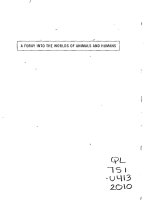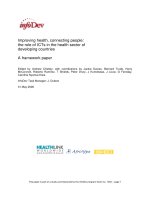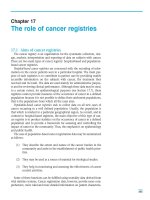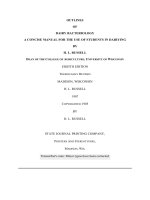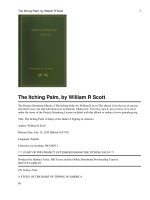The Burden of Cancer in Asia doc
Bạn đang xem bản rút gọn của tài liệu. Xem và tải ngay bản đầy đủ của tài liệu tại đây (4.3 MB, 92 trang )
P F I Z E R F A C T S
The Burden of Cancer
in Asia
Medical Division
PG283663
© 2008 Pfizer Inc. All rights reserved.
Printed in USA/December 2008The burden of cancer in Asia
I
n 2002, 4.2 million new cancer cases—39% of new cases worldwide—were diagnosed among
3.2 billion persons (48% of the world population) living in the fifteen most highly developed
countries in South, East, and Southeast Asia: Japan, Taiwan, Singapore, South Korea, Malaysia,
Thailand, China, Philippines, Sri Lanka, Vietnam, Indonesia, Mongolia, India, Laos, and
Cambodia. China and India, together accounting for 37% of the worldwide population, reported
3 million of these newly diagnosed cancer cases.
Demographic characteristics vary widely in these fifteen countries—median ages in India, China,
and Japan are 25, 34, and 44 years, respectively—yet collectively, they carry a disproportionate
burden of worldwide liver, stomach, and esophageal cancer. Three fourths of new worldwide liver
cancer cases in males and two thirds in females occur in these fifteen Asian countries. Greater
than 50% of the world’s new cases of stomach cancer, and greater than 70% of newly diagnosed
esophageal cancer worldwide occur in these Asian countries. China alone contributes more than
half of the world’s newly diagnosed liver and esophageal cancer cases, and 42% of newly
diagnosed stomach cancer cases. By comparison, fewer than 4% of the world’s new cases of each
of these cancers occur in the United States.
In 7 of these Asian countries, lung cancer has the highest incidence rate (age-standardized) of all
cancers in males, and breast cancer is the highest incident cancer for females. Lung cancer has the
highest death rate (age-standardized) for males in the majority of these Asian countries, and breast
cancer ranks among the top-five mortality rate cancers for females in all but 2 of the Asian countries.
There are 3.6 million males and 4.0 million females living with cancer in these Asian countries;
China alone has 1.6 million male and 1.5 million female cancer survivors. The magnitude of the
surviving population is a function of incidence rates—new cases diagnosed during the year—as
well as associated mortality rates. Although the United States has a much smaller population than
China (303 million), it has 50% more cancer survivors (2.4 million males and 2.3 million females
living with cancer). In most of the Asian countries, cancer of the colon and rectum is the most
common among male cancer survivors; among female survivors, breast cancer is the most
common in most Asian countries.
This issue of Pfizer Facts presents new analyses of international databases to gain insight into the
burden of cancer among Asians, including cancer morbidity and mortality, and preventable risk
factors. For purposes of comparison, cancer statistics are also presented for the United States.
Margaret McDonald, PhD Robin P. Hertz, PhD Susan W. Pitman Lowenthal MD MPH
Director Senior Director/Team Leader Senior Medical Director, Oncology
Comparative Effectiveness & Comparative Effectiveness & Medical Lead Asia Oncology
Population Studies Population Studies Medical and Regulatory Affairs Japan/Asia
Evidence-Based Strategies Evidence-Based Strategies
Highlights 1
Demographic characteristics 5
Morbidity and mortality 8
Preventable risk factors 63
Appendices
I. Methods 67
II. Data tables 72
About the analyses
This report presents cancer statistics for the fifteen most highly developed countries
in South, East, and Southeast Asia; in decreasing order, they are: Japan, Taiwan,
Singapore, South Korea, Malaysia, Thailand, China, Philippines, Sri Lanka,
Vietnam, Indonesia, Mongolia, India, Laos, and Cambodia. For purposes of
comparison, cancer statistics are also presented for the United States.
The ranking is based on the Human Development Index (HDI), a measure created
by the United Nations Development Program to categorize countries as developed,
developing, or underdeveloped.
The HDI is scaled from zero to one, and is an average of three component indices:
• Life expectancy at birth, expressed as a normalized index.
• Knowledge and education, as measured by the adult literacy rate (two-thirds
weighting) and the combined primary, secondary, and tertiary gross enrollment
ratio (one-third weighting).
• Gross domestic product (GDP) per capita at purchasing power parity (PPP) in
United States dollars, expressed as a normalized index.
An HDI value of 0.8 or more signals a “high development” country. Included in
this category are five Asian countries: Japan, Taiwan, Singapore, Korea, and
Malaysia. The remaining ten countries have HDI between 0.5 and 0.8, and are
classified in the “medium development” group.
Analyses in this report are based on the latest available data describing cancer
incidence, prevalence, and mortality in the GLOBOCAN 2002 database covering
all countries of the world, maintained by the International Agency for Research
on Cancer (IARC). The quality of the data varies by country, depending on the
extent and accuracy of the locally available data. Data from the population-based
Taiwan cancer registry for the year 2005 are used for Taiwan cancer incidence
and mortality but data availability are limited to their 10 most common cancers.
Data on preventable risk factors are taken from the World Health Organization
Statistical Information System (WHOSIS) database 2003, 2005, an interactive
database bringing together core health statistics for the WHO member states.
Population statistics are based on data from the United States Census Bureau
International Data Base (IDB), 2008. All age-standardized rates in the report use
the World Health Organization (WHO) World Standard Population.
Throughout this report, non-melanoma skin cancers are excluded from the analyses
of total cancers, and breast cancer analyses are limited to cases in females.
South Korea is referred to as Korea in this report.
The burden of cancer in Asia
Highlights
Demographic characteristics
• The fifteen Asian countries covered in this report—Japan, Taiwan, Singapore,
Korea, Malaysia, Thailand, China, Philippines, Sri Lanka, Vietnam, Indonesia,
Mongolia, India, Laos, and Cambodia—comprise 48% of the world’s
population (6.7 billion).
• China and India together account for 37% of world population.
• The median age of the population varies widely among the countries, from a
low of 19 years in Laos (3% aged 65 years and older) to a high of 44 years in
Japan (22% aged 65 years and older). Median ages in the populations of China
and India are 34 years and 25 years, respectively.
Morbidity and mortality
Incidence
• Among the 15 Asian countries the highest incidence rates (age-standardized) for
total cancer (all sites) in males are in Taiwan, Korea, and Japan; female total
cancer incidence rates are highest in Taiwan, Singapore, and Philippines.
• Lung cancer is the most common or second-most common cancer among males
in all Asian countries but for India, Japan, Mongolia, and Taiwan.
• Stomach cancer is the highest incident-rate cancer among both males and
females in Korea; it is the most common among females in China, and the most
common among males in Japan.
• Among females, breast cancer is the highest incident cancer in 7 countries—
Indonesia, Japan, Malaysia, Philippines, Singapore, Sri Lanka, and Taiwan.
• 41% of all new cancers diagnosed in males, and 37% of cancers diagnosed in
females are in the fifteen Asian countries—about 3 times as many cases as that
in the United States.
• Liver, stomach, and esophageal cancer are relatively common in Asia:
— Three fourths of worldwide liver cancer cases in males and two thirds in
females occur in the fifteen Asian countries.
■ China has more than half of newly diagnosed liver cancer cases in
the world.
The burden of cancer in Asia
1
— The fifteen Asian countries account for almost two thirds of new stomach
cancer cases in males and more than half of new cases in females.
■ China has greater than 40% of the world’s new stomach cancer cases.
— Esophageal cancer also occurs disproportionately in Asia—greater than
70% of new cases in males and females occur in the fifteen Asian countries.
■ China has 55% of all new cases of esophageal cancer.
Mortality
• The all-cancer mortality rate among males in Mongolia (204 deaths per
100,000) is higher than any other Asian country included in this report.
• Korea, Taiwan, Singapore, China, and Japan have all-cancer male mortality
rates ranging from 180 to 154 deaths per 100,000 males; each of these countries
has an all-cancer mortality rate in excess of that seen among males in the United
States (153 per 100,000 males).
• Among females, the all-cancer mortality rate is highest in Mongolia (136 per
100,000 population), followed by Philippines and Singapore (124 and 109 per
100,000 population, respectively). Females in the other countries included in this
report have mortality rates lower than that observed among females in the
United States (112 per 100,000 population).
• Breast cancer in females is among the top 5 mortality-rate cancers in thirteen of
the fifteen Asian countries. The Philippines has the highest breast cancer mortality
rate and the lowest mortality-to-incidence ratio (surrogate measure of survival).
• The mortality rate for cancer of the esophagus in males is highest in China, more
than 4 times the mortality rate of this cancer among males in the United States.
• Mongolia has by far the highest mortality rate for liver cancer in males and
females. Thailand, Taiwan, China, and Korea also have substantially higher liver
cancer mortality rates than the United States.
• Lung cancer mortality rates are much higher for males than females in all Asian
countries. The mortality rates in the Asian countries are lower than those in the
United States for both males and females.
• The mortality rate for stomach cancer in males and females is highest in China,
Korea, Japan, and Mongolia. The mortality rates for males and females in these
countries are more than 7 times the corresponding rates in the United States.
The burden of cancer in Asia
2
The burden of cancer in Asia
3
Prevalence
• In fourteen of the fifteen Asian countries (prevalence data unavailable for
Taiwan) there are 3.6 million males and 4.0 million females living with cancer
(diagnosed within the past five years)—China alone has 1.6 million male and
1.5 million female survivors. Even though the United States has a much smaller
population than China, it has 50% more cancer survivors (2.4 million males
and 2.3 million females living with cancer).
• In most of the Asian countries, cancer of the colon and rectum is the most
common among male cancer survivors; breast cancer is the most common
among female survivors.
• The most prevalent cancer in India among females is uterine cervix (370,000
survivors). This is the largest such population in any of the fourteen Asian
countries.
• Stomach cancer is the most prevalent cancer among males in China (365,000
survivors) and Japan (244,000 survivors).
Preventable risk factors
• Greater than 50% of males in Indonesia, China, Malaysia, and Korea are
current smokers, about twice the prevalence of current smoking among males in
the United States (26%).
• Females in the United States smoke at a higher rate (22%) than females in any
of the fifteen Asian countries.
• Alcohol consumption is highest in Korea (7.9 liters per person per year), and
lowest in Indonesia (0.1 liters per person per year).
• The average amount of alcohol consumed per person per year is lower in all
fifteen Asian countries than in the United States (8.6 liters per person per year).
5
Demographic characteristics
This report presents cancer statistics for fifteen South Asian and Southeast Asian
countries: Japan, Taiwan, Singapore, South Korea, Malaysia, Thailand, China,
Philippines, Sri Lanka, Vietnam, Indonesia, Mongolia, India, Laos, and Cambodia.
For purposes of comparison, statistics are also presented for the United States.
These fifteen Asian countries comprise 48% of the world’s population. China and
India together account for 37% of the worldwide population.
Distribution of the worldwide population
Distribution of the worldwide male population
Distribution of the worldwide female population
Source: US Census Bureau, International Data Base 2008.
Total population=6.7 billion
United States
5
%
China 20%
India 17%
13 Asian countries 11%
1
5 Asian
countries
48%
Rest of
w
orld
47%
Source: US Census Bureau, International Data Base 2008.
Total population=3.38 billion
United States
4%
China 20%
India 18%
13 Asian countries 11%
15 Asian
countries
49%
Rest of
world
47%
Total may not add to 100% because of rounding.
Source: US Census Bureau, International Data Base 2008.
Total population=3.33 billion
United States
5%
China 20%
India 17%
13 Asian countries 11%
15 Asian
countries
48%
Rest of
world
48%
The burden of cancer in Asia
6
The median age of the population across the fifteen Asian countries varies widely,
from 19 years in Laos, 25 years in India, 34 years in China, and 44 years in
Japan. Less than 10% of the population is elderly (65 and older) in all countries
except Japan (22%), Taiwan (11%), and Korea (11%).
Demographic characteristics by country
Population
Number Male Median age Proportion Proportion Proportion
(millions) (%) (years) less than 15 15 to 64 65 years
years of age years of age and older
Country (%) (%) (%)
Cambodia 14 49 22 33 63 4
China 1,338 51 34 20 72 8
India 1,148 52 25 32 63 5
Indonesia 238 50 27 28 66 6
Japan 127 49 44 14 65 22
Korea 48 50 37 17 72 11
Laos 7 50 19 41 56 3
Malaysia 25 50 25 32 63 5
Mongolia 3 50 25 28 68 4
Philippines 96 50 22 36 60 4
Singapore 5 49 38 15 77 9
Sri Lanka 21 49 30 24 68 8
Taiwan 23 51 36 17 72 11
Thailand 65 49 33 21 70 9
Vietnam 86 50 27 26 69 6
United States 304 49 37 20 67 13
Source: United States Census Bureau, International Data Base 2008.
Morbidity and mortality
Incidence
The incidence rate of cancer in males and females (all sites) tends to be highest in
northeastern and lowest in southern Asian countries.
Incidence rates for total cancers in males in Asian countries and the United States
Excludes non-melanoma skin cancer.
Rate per 100,000.
Age-standardized to the World Standard Population.
Source: Taiwan Cancer Registry Annual Report 2005 (Taiwan); GLOBOCAN 2002, IARC (all other countries).
The burden of cancer in Asia
8
95 – 104
105 – 144
145 – 214
215 – 410
Mongolia
China
Pakistan
India
Sri Lanka
Nepal
Bhutan
Burma
Bangladesh
Taiwan
Malaysia
Singapore
Indonesia
Philippines
Vietnam
Laos
Cambodia
Thailand
South Korea
Japan
North Korea
Rate per 100,000
United States
Incidence rates for total cancers in females in Asian countries and the United States
Excludes non-melanoma skin cancer.
Rate per 100,000.
Age-standardized to the World Standard Population.
Source: Taiwan Cancer Registry Annual Report 2005 (Taiwan); GLOBOCAN 2002, IARC (all other countries).
The burden of cancer in Asia
9
95 – 104
105 – 144
145 – 214
215 – 410
Mongolia
China
Pakistan
India
Sri Lanka
Nepal
Bhutan
Burma
Bangladesh
Taiwan
Malaysia
Singapore
Indonesia
Philippines
Vietnam
Laos
Cambodia
Thailand
Japan
North Korea
Rate per 100,000
United States
South Korea
The burden of cancer in Asia
10
Taiwan and Korea have the highest all-cancer incidence rate (age-standardized) for
males in Asia (299 and 286 new cases per 100,000 males, respectively). China has
a total cancer incidence rate for males of 205 per 100,000 males, but, given the
size of its population, this translates to 1.3 million estimated new male cancer
cases annually, exceeding that of any other Asian country. India has one of the
lowest total cancer incidence rates for males in Asia (99 per 100,000 males), but
accounts for 404,000 new male cases annually. The all-cancer incidence rate for
males in the United States (407 per 100,000 males) is higher than the rate in any
Asian country and accounts for 762,000 new cases annually.
The all-cancer incidence rate among females in the fifteen Asian countries is
highest in Taiwan, Singapore, and Philippines—in comparison, incidence in the
United States is much higher than in any of the Asian countries. In China, the
female all-cancer incidence rate is 130 per 100,000 females, accounting for
867,000 new cases annually. The total cancer incidence rate for females in India
(104 per 100,000 females) is slightly higher than its incidence rate in males, and
accounts for 448,000 new female cases annually.
The burden of cancer in Asia
11
Excludes non-melanoma skin cancer.
Age-standardized to the World Standard Population.
Source: Taiwan Cancer Registry Annual Report 2005 (Taiwan); GLOBOCAN 2002, IARC (all other countries).
Males
Females
Rate per 100,000
Cambodia
China
India
Indonesia
Japan
Korea
Laos
Malaysia
Mongolia
Philippines
Singapore
Sri Lanka
Taiwan
Thailand
Vietnam
United States
Incidence rates for total cancers by gender and country
0 50 100 150 200 250 300 350 400 450
The burden of cancer in Asia
12
Lung cancer is the most common or second-most common cancer among males in
all Asian countries but for India, Japan, Mongolia, and Taiwan. Liver cancer has
the highest incidence rate of any cancer in Laos, Mongolia, Taiwan, and Thailand.
Stomach cancer is the highest incident rate cancer in both Japan and Korea, and
the second highest incident cancer in Cambodia, China, and Mongolia. Cancer of
the oral cavity is most common in India and Sri Lanka, but is among the top-five
cancers for males in only 1 other country, Cambodia. In the United States, prostate
cancer is by far the highest incident cancer among males, occurring at twice the
rate of lung cancer, the next highest. The prostate cancer rate in the United States
exceeds the rates in each of the fifteen Asian countries.
Breast cancer among females is the most common or second-most common cancer
in all but 3 of the Asian countries (China, Mongolia, and Thailand). Stomach
cancer is the highest incident cancer among females in China and Korea; uterine
cervix cancer is highest in Cambodia, India, Laos, Thailand, and Vietnam. Breast
cancer is also the most common cancer among females in the United States. The
incidence of breast cancer in the United States is 2 or more times the rate observed
in any of the fifteen Asian countries.
The burden of cancer in Asia
13
Rate per 100,000
Age-standardized to the World Standard Population.
Source: Taiwan Cancer Registry Annual Report 2005 (Taiwan); GLOBOCAN 2002, IARC (all other countries).
Cambodia
China
India
Indonesia
Japan
Korea
Laos
Malaysia
Mongolia
Philippines
Singapore
Sri Lanka
Taiwan
Thailand
Vietnam
United States
Incidence rates for breast cancer in females by country
0
10 20 30 40 50 60
70
130
101
Selected cancers
Breast
In Asia, the incidence rate of breast cancer among females is highest in Taiwan,
Singapore and Philippines. Breast cancer incidence rates in China and India are
the same, 19 per 100,000 females; the estimated number of new breast cancer
cases annually is 126,000 for China and 83,000 for India.
The breast cancer incidence rate in the United States is much higher than that in
any of the Asian countries (101 per 100,000 females) and may, in part, be due to
breast cancer screening. Nearly 210,000 new breast cancer cases are diagnosed
annually in the United States.
The burden of cancer in Asia
14
Colon and rectum
The incidence of colorectal cancer in males and females is highest in Japan and
Taiwan, with rates comparable to the United States. Incidence rates among males
are higher than among females in all countries.
Cambodia
China
India
Indonesia
Japan
Korea
Laos
Malaysia
Mongolia
Philippines
Singapore
Sri Lanka
Taiwan
Thailand
Vietnam
United States
Incidence rates for cancer of the colon and rectum by gender and country
Rate per 100,000
Age-standardized to the World Standard Population.
Source: Taiwan Cancer Registry Annual Report 2005 (Taiwan); GLOBOCAN 2002, IARC (all other countries).
130
0 10 20 30 40 50 60 70
Males
Females
The burden of cancer in Asia
15
Cambodia
China
India
Indonesia
Japan
Korea
Laos
Malaysia
Mongolia
Philippines
Singapore
Sri Lanka
Taiwan
Thailand
Vietnam
United States
Incidence rates for cancer of the esophagus by gender and country
Rate per 100,000
Data unavailable for females, Taiwan.
Age-standardized to the World Standard Population.
Source: Taiwan Cancer Registry Annual Report 2005 (Taiwan); GLOBOCAN 2002, IARC (all other countries).
130
0
10
20 30 40 50 60 70
Males
Females
Esophagus
China has the highest incidence of esophageal cancer in males and females (27
and 12 cases per 100,000 males, females, respectively) in the Asian countries and
the United States. China diagnoses an estimated 174,000 new male cases and
80,000 new female cases of esophageal cancer yearly.
The burden of cancer in Asia
16
Liver
Although Mongolia has the highest incidence of liver cancer among males and
females (99 and 57 per 100,000 males, females, respectively) in the fifteen Asian
countries, these translate to less than 700 new cases in males and 500 in females
yearly. In China, the incidence rate of liver cancer in males (38 per 100,000 males)
and females (14 per 100,000 females) accounts for an estimated 251,000 male
and 95,000 female diagnoses annually.
Cambodia
China
India
Indonesia
Japan
Korea
Laos
Malaysia
Mongolia
Philippines
Singapore
Sri Lanka
Taiwan
Thailand
Vietnam
United States
Incidence rates for liver cancer by gender and country
Rate per 100,000
Age-standardized to the World Standard Population.
Source: Taiwan Cancer Registry Annual Report 2005 (Taiwan); GLOBOCAN 2002, IARC (all other countries).
130
0
10
20 30 40 50 60 70
Males
Females
99
The burden of cancer in Asia
17
Cambodia
China
India
Indonesia
Japan
Korea
Laos
Malaysia
Mongolia
Philippines
Singapore
Sri Lanka
Taiwan
Thailand
Vietnam
United States
Incidence rates for cancer of the lung and bronchus by gender and country
Rate per 100,000
Age-standardized to the World Standard Population.
Source: Taiwan Cancer Registry Annual Report 2005 (Taiwan); GLOBOCAN 2002, IARC (all other countries).
130
0
10
20 30 40 50 60 70
Males
Females
Lung and bronchus
Lung cancer incidence among males is highest in Korea, Philippines, Singapore, and
China, and lowest in India and Sri Lanka. The rate among males in the United
States is higher than in any of the Asian countries.
Lung cancer incidence among females is highest in China, Singapore, and Taiwan,
and lowest in India and Sri Lanka. The United States incidence rate among females
is higher than the incidence in any of the fifteen Asian countries.
The burden of cancer in Asia
18
Prostate
The incidence of prostate cancer in the fifteen Asia countries is much lower than
that in the United States; in part, this may be due to United States prostate cancer
screening measures.
Rate per 100,000
Age-standardized to the World Standard Population.
Source: Taiwan Cancer Registry Annual Report 2005 (Taiwan); GLOBOCAN 2002, IARC (all other countries).
Cambodia
China
India
Indonesia
Japan
Korea
Laos
Malaysia
Mongolia
Philippines
Singapore
Sri Lanka
Taiwan
Thailand
Vietnam
United States
Incidence rates for prostate cancer in males by country
0
10
20 30 40 50 60
70
130
125
Stomach
The incidence of stomach cancer among males and females is highest in Korea
(70 and 27 per 100,000 males and females, respectively), followed by Japan,
Mongolia, and China. Stomach cancer is much more common in these countries
than in the United States.
The burden of cancer in Asia
19
Cambodia
China
India
Indonesia
Japan
Korea
Laos
Malaysia
Mongolia
Philippines
Singapore
Sri Lanka
Taiwan
Thailand
Vietnam
United States
Incidence rates for stomach cancer by gender and country
Rate per 100,000
Age-standardized to the World Standard Population.
Source: Taiwan Cancer Registry Annual Report 2005 (Taiwan); GLOBOCAN 2002, IARC (all other countries).
130
0
10
20 30 40 50 60 70
Males
Females
130

